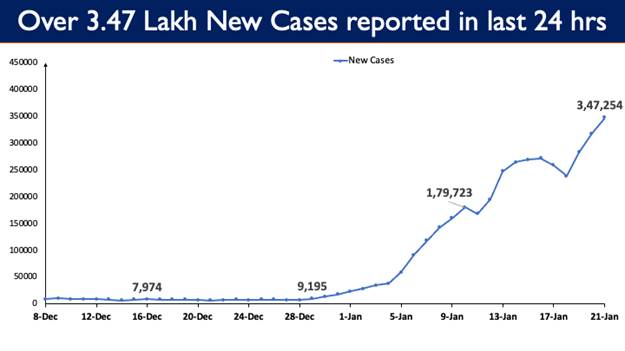
COVID-19 Notes
 By Dr. Satish K Gupta*
By Dr. Satish K Gupta*
Why the next variant can be faster and sharper?
Mutations in Virus
It is the inherent property of Coronaviruses to change. The virus gets a chance to thrive and evolve when its stay in the host is longer. Hence immunocompromised hosts provide a perfect fertile environment for evolution by mutation. Many mutants evolve during the evolution process, but some mutations could be disadvantageous to the virus itself. Only the viruses with the evolutionary advantage will flourish in the host, slowly replacing the old virus or those with non-advantageous mutations. The thriving virus continues to make more copies and finally starts infecting a larger number of people in the society during sneezing and wheezing. If the new variant is much faster than the prevailing strain, it ultimately overtakes the previous mutant to become the dominant strain. Super-spreading events take to mutants to large numbers of people, wherein variants with entry advantage flourish and others fizzle out.
What is supporting evidence to the theory of mutations occurring in ‘Immunocompromised Host’?
Mutations found in variants of concern were spotted in SARS-CoV-2 samples isolated from people with compromised immune systems, whose infections lasted for months. It led researchers to speculate that long-term infections might allow the virus to explore different combinations of mutations. Opportunities of mutation would obviously be limited in immune-competent hosts clearing the virus in a short time.

How have the early predictions about Sars-Cov 2 fared with time?
As the pandemic started in early 2020, many evolutionary biologists were quick to predict that the new pathogen would never be eradicated. Instead, it would become endemic. It would become the fifth Coronavirus to permanently establish itself in humans, alongside four ‘seasonal’ coronaviruses that cause relatively mild colds and have been circulating in humans for decades or more.
What formed the basis of early predictions?
Early lab experiments on stacked blood samples from 1980 to 2000 proved that people had immunity to coronaviruses from the recent past, but not to those from the future, suggesting that the Coronaviruses have been evolving to evade immunity. And the recent lineages of Alpha, Beta, Gamma, Delta, and Omicron have proved the point.
Is SARS CoV-2 a fast-mutating virus?
No, genome sequencing early in the pandemic showed the virus has been picking up about two single-letter mutations per month. This rate of change is about half that of influenza and one-quarter that of HIV, both RNA viruses. Slow change is courtesy error-correcting enzyme Coronaviruses possess rare among other RNA viruses.
How do scientists recognise significant mutations in SARS CoV-2?
Though mutations can occur anywhere in the genome sequence of the virus, changes in the genes numbers from ~315 to ~525, which code for Receptor Binding Domain (RBD) of Spike protein, may confer attachment advantage to the virus. Similarly, the changes in genes coding for furin cleavage site (genes ~684 to ~687) might ease the entry of the virus into the host cell. All the variants of concern Alpha, Beta, Gamma, Delta, and Omicron have a primary mutation in the genes coding for RBD.
The evolution of Sars Cov-2 so far
An early mutation called D614G within the gene encoding the virus’s spike protein seemed to offer a slight transmissibility boost. But this gain was nothing like the leaps in transmissibility observed with Delta and Alpha.
Alpha variant spread at least 50% faster than earlier circulating lineages in November 2020. Around the same time, virologists in South Africa found another mutation-laden variant B.1.351 — later named Beta. A highly transmissible variant called Gamma was tracked to Brazil shortly after.
Variants such as Omicron and Delta carry mutations that blunt the potency of antibodies raised against past versions of SARS-CoV-2.
Whatever their origins, all three variants seemed to be more infectious than the strains they displaced. But Beta and Gamma also contained mutations that blunted the potency of infection-blocking ‘neutralizing’ antibodies triggered by previous infection or vaccination. It raised the possibility that the virus was beginning to behave in the ways predicted by evolution scientists like Jesse Bloom.
The descent of Delta
The Delta variant was identified in India’s Maharashtra state during a ferocious second wave of COVID-19 in 2021. It was about 60% more transmissible than Alpha, making it several times as infectious as the first circulating strains of SARS-CoV-2. Delta behaved a kind of Super-Alpha and soon became the dominant variant driving a fresh surge of cases worldwide.
Compared with other variants, including Alpha, Delta multiplies faster and to higher levels in the airways of infected individuals, potentially outpacing initial immune responses against the virus.
Origin of Omicron
Most researchers expected the next variant to descend from Delta lineages. But Omicron undermined all those predictions. Instead, it turned out to be a kin of Beta from Botswana. The variant harbours around 30 changes to spike, many shared with the other variants of concern.
The swift rise in cases of Omicron in the world suggests that the new variant has a fitness advantage over Delta. Omicron carries some of the mutations associated with Delta’s sky-high infectivity. Early trends indicate that Omicron’ is 2-3 times more transmissible than Delta.
Omicron’s rise is primarily due to its ability to infect people immune to Delta through vaccination or previous infection – the immune invasion effect inherited from its predecessor Beta. However, its limited ability to multiply in lung tissues, as proven by experiments in Hong Kong, is likely to make it a mild variant. However, its multifold replication capability in upper airways is the reason for its fast transmission, making it the dominant player in the third wave of the pandemic.
The T-cell advantage despite Omicron
Possibly repeated exposure to different versions of spike — through infection with different virus strains and/or vaccines — humans could finally build up a wall of immunity that SARS-CoV-2 finds difficult to invade. Possibly mutations could overcome some people’s antibody-related immunity but are unlikely to foil responses across an entire population, as T-cell-mediated immunity comes to rescue and seems to be more resilient to changes in the viral genome, maintaining protection against severe disease, hospitalization, and death. Patrolling T-cells upon encountering the fresh challenge by the virus may take a week to ten days to mount an effective defense by forming a new crop of antibodies.
What could be next variant like?
The virus can go in multiple directions. The vaccines have acted as speed breakers as far as the severity of Covid-19 is concerned, but if they serve as permanent roadblocks, will depend upon waning immune responses and the evolution of the virus. It might be too early to comment upon either of the two.
Nevertheless, the virus has been giving us nearly six months before descending into a new avatar. As the jabs are still highly effective, vaccinating as many as possible in the coming four to five months, especially in Africa and low-income countries, could stop the virus from unlocking changes that could drive a new wave. Just sending vaccines may not be sufficient as many poor countries lack the basic infrastructure like cold storage, transport, and workforce. With one and half months already gone, a quick and wholehearted concerted effort by wealthy and affluent nations can turn tides.
What makes Sars Cov-2 a perpetual virus?
Vaccination may make the existing population immune to the virus, but new children by birth will remain vulnerable to attack by an already established human reservoir of the virus, requiring regular childhood vaccination. Upcoming Nasal Vaccines by Bharat Biotech, AstraZeneca, and CanSino may help in not only blocking the chain of transmission but also dissipating the human reservoir.
Also, being a zoonotic spillover virus, continued circulation in animal reservoirs, such as mink or white-tailed deer, brings some potential for surprising changes, such as immune escape or heightened severity. Hence, further research needs to be directed to define the animal source of the virus.
Fatigue and Uncertainty driven by clueless political decisions may cost dear to the human race.
Updates
3,47,254 new cases recorded in the last 24 hours till 9 am today

9,692 Total Omicron cases detected so far; an increase of 4.36% since yesterday
Daily positivity rate (17.94%)
Weekly Positivity Rate (16.56%)
Also read: COVID-19: How will the pandemic end?
*Dr. Satish K Gupta is an MD in Medicines, a Visiting Senior Consultant Physician and Internist at Max Super Speciality Hospital, and a Clinical Assistant Professor at GS Medical College, Chaudhary Charan Singh University, Meerut. He is the author of Journey of COVID in India: A Doctor’s Perspective.





